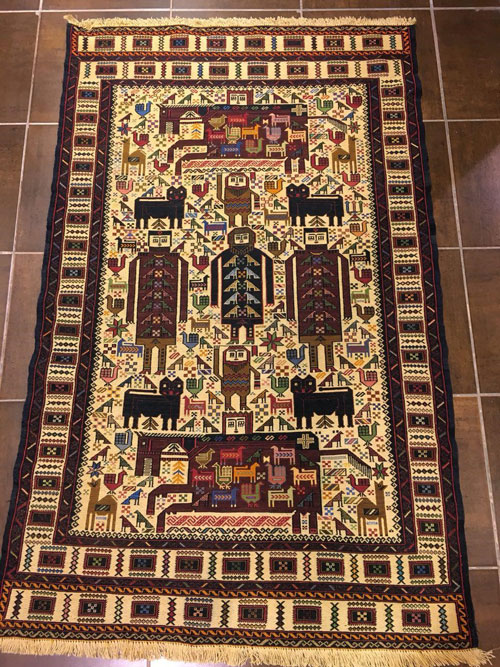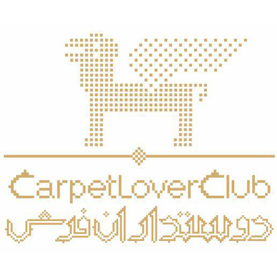How Gabbeh Rugs Are Made?
qabbeh metrial
Gabbeh rugs are created from high quality wool that comes from the tribe’s own sheep. Over the course of a year, the tribe herds its sheep hundreds of miles. The nomads reach very high altitudes. Their journeys stretch from the area between the highland pastures north of Shiraz in the Zargos Mountains (where they spend their summers) to the winter pasture lands near the Persian Gulf. Sheep grazed in high altitudes produce more lanolin. Better quality wools have this higher lanolin content, giving them their sheen, softness and resistance to becoming stained.
gabbeh yarn dying
The dyes used in Gabbeh carpets can be either found or purchased. Some all natural, vegetable, mineral and insect dyes are found by the Qashqai people in the different climatic environments they travel thru. And, some dyes are purchased when they stop in towns to trade their finished carpets for more materials. The use of all natural “vegetable” dyes allows for the wool used in the crafting of these amazing works of art to retain its lanolin despite being dyed. Once in a great while, you will find a gabbeh rug dyed with synthetic dye. Even more rarely, you may see materials like tinsel playfully inserted into the work by girls who are learning. The majority of the wool used in the construction of Gabbeh rugs is handspun, using an instrument called a drop spindle. The woman who spins the wool holds the dyed wool she wishes to spin into a usable yarn in one hand. She keeps the drop spindle spinning with the other hand. If you would like to see how this is done please see the video on our site for a demonstration. After the wool has been dyed and handspun, it can then be taken to the loom and used to begin to handknot a rug. Most Gabbeh area rugs are knotted using both Turkish symmetrical and Persian asymmetrical knots. Sometimes a rug is even constructed using both types of knots in the same rug. Because the all the Qashqai tribes use both types of knots, it is difficult to tell from which individual tribe any one rug has come from.
gabbeh loom

The construction of a Persian gabbeh rug begins with laying the frame of the ground loom to the desired width and length of the finished product. Horizontal (or ground) looms are the simplest type of loom. They are easily assembled and dismantled and so are the best choice for those who construct hand knotted rugs as part of a nomadic lifestyle. Rugs woven on horizontal looms are usually small. The bars that make up the frame of the loom are attached to the ground by stakes or nails. The next step is to stretch the warp strands between the top and the bottom (horizontal) bars of the frame. After the warp is completed, the weft of ground loom is set up. The weft somewhat resembles the strings of a harp. It is around these “strings” of the weft that the knots that make up the pile—and the design of the rug—can begin to be tied. A Persian Gabbeh area rug is created from the bottom up, row by row, knot by knot; the design is carefully crafted by the weaver. The way in which these works are created, piece by piece, knot by knot, point by point,most closely resembles the style of pointillism in painting. But with pointillism, the artist can choose any point upon the canvas at any moment, to lay down paint, and thus establish a framework in creating the larger design of the masterpiece. In contrast, the rug weaver must progress along a horizontal line, laying down each point of their grand design in an organized manner. This requires a great deal of skill; they must be able to remember exactly the final design they wish to create, and they must go about it piece by piece, from the bottom up, without having access to laying down any framework of the larger design they wish to create with their canvas of wool. Taking this process into account, one begins to see why a Persian rug has been, throughout history, and still to this day, one of the world’s most prized artistic possessions.
gabbeh size
A typical size for a Gabbeh carpet is 3 feet by 5 feet. The time it takes to create just one rug of this modest size can vary depending on the knot count. Generally it takes approximately 18 and 25 hours to create this small rug. Tribal Gabbeh rugs are usually of lower knot count when compared to those more common Persian rugsلینک بهمعرفی فرش دستباف ایرانی made in shops in the towns and cities on permanent vertical looms. But due to the quality of wool, the length of the pile and the wear and tear of being woven on a ground loom (with the weaver most often sitting upon the area of the rug that has already been finished), Gabbehs are of extreme durability. In additionto this wear and tear on the rug, looms must be taken down, rolled up and moved to different locations as the tribe moves from place to place. Therefore the knots tend to be very tight, in a way that cannot be achieved in more modern shops and on more permanent looms. The nomadic lifestyle of the Qashqai people often requires that they use varying qualities of dye materials, hand spin their wool as it is harvested from their flocks, set up and take down their looms, and work on their rugs in different locations. Due to these factors,
their rugs are often times not perfectly symmetrical in overall size. The lifestyle also contributes to the wonderful and sometimes awe inspiring overall variations in the patterns and colors used within one rug to complete a grander design. Often times the variation in color in a rug tells a story, a story of when the tribe migrated, of what new environments they encountered and of how many people took part in the making of the rug.
Patterns

The patterns of the carpet are of a simple type with only a few elements of decorative, mostly rectangular objects containing animals. During the last decades, the weavers have had to meet the demands of the west and have therefore, resorted to using large light fields with chary pattering in the Gabbeh carpets.
persian and indian gabbeh diffrence
Weavers from India have acted quickly to copy these carpets, but one must pay attention to this as there is a major difference between a Persian and a Indo Gabbeh carpet. Mostly this can be determined by the quality of the wool that is noticable, the Persian variant is much softer. The Persian variant is also much more durable and the quality is definitely better.
what is other names of gabbeh?
At present, there are different names given to Gabbeh carpets such as Basic, Amalehbaft, Kashkooli, Luribaft, Sumak and Baluch Gabbeh. A Gabbeh Kashkooli is a carpet with a higher knot density and a shorter pile than the usual Gabbeh carpets.
New & Revised Versions
Because Gabbeh rugs have been modernised in their design, they resemble the traditional rugs only in a superficial way. They are so popular thanks to their playful and colourful design. In case of modern Gabbeh rugs, the typical Gabbeh composition ia characterised by big and colourful fields also. Superficially Gabbeh rugs are similar to modern rugs in ethno style and they are designed with vibrant red or blue. This means that they can be applied as high-contrast runner rugs in living zone. Gabbeh rugs act refreshing and they catch everyone’s eye. Their cheerful design is making Gabbeh rugs one of more popular living accessories.



